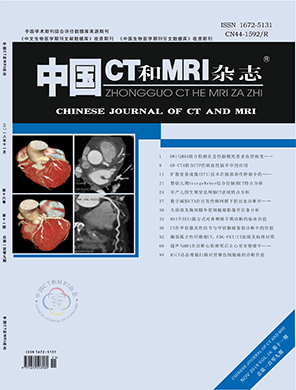摘要
目的探讨三维CT重建及MRI 检查在胫骨平台隐性骨折(TPOF)诊疗 中的应用价值。方法 收集2016年11月 至2018年11月我院收治的125例疑诊为 TPOF患者的临床资料,分析所有患者三 维CT重建及MRI影像资料,比较两种影 像学方法诊断TPOF的敏感度、特异度、 准确度。结果 共125例疑诊TPOF患者 中,最终临床诊断TPOF共104例,无骨 折21例;以最终诊断临床诊断为金标 准,MRI诊断TPOF的敏感度、准确度分 别为98.08%、98.40%,均明显高于三维 CT重建的75.00%、79.20%(P<0.05),而 两者特异度均为100.00%。对于累及骨 皮质的TPOF,三维CT重建的敏感度、特 异度、准确度分别为100.00%(73/73)、 100.00%(29/29)、100.00%(102/102), 均优于MRI的80.82%(59/73)、 67.44(29/43)、86.27%(88/102)。三维 CT重建与MRI在骨折部位、关节面塌陷、 骨折错位的显示满意度评分比较上差异 无统计学意义(P>0.05),而MRI在周围软 性组织(半月板、韧带等)显示满意度评 分明显高于CT(P<0.05)。结论 对于X线 检查后疑诊TPOF,MRI可作为进一步明确 诊断的首选方法,而联合三维重建CT有 助于提高诊断准确度。
Objective To explore the application value of three-dimensional CT reconstruction and MRI in the diagnosis and treatment of tibial plateau occult fracture (TPOF). Methods The clinical data of 125 patients with suspected TPOF admitted to our hospital from November 2016 to November 2018 were collected. Three-dimensional CT reconstruction and MRI images of all patients were analyzed. The sensitivity, specificity and accuracy were compared between the two imaging methods for the diagnosis of TPOF. Results Of the total 125 patients with suspected TPOF, 104 cases were finally diagnosed as TPOF and 21 cases without fracture. The final clinical diagnosis was golden standard. The sensitivity and accuracy of MRI in diagnosis of TPOF (98.08% and 98.40%) were higher than those of three-dimensional CT reconstruction (75.00% and 79.20%) (P<0.05). The specificity of both was 100.00%. For the diagnosis of TPOF involving the cortex of bone, the sensitivity, specificity and accuracy of three-dimensional CT reconstruction [100.00% (73/73), 100.00% (29/29) and 100.00% (102/102)] were superior to those of MRI [80.82% (59/73), 67.44 (29/43), 86.27% (88/102)]. There was no statistically significant difference between three-dimensional CT reconstruction and MRI in satisfaction scores of displaying the site, articular surface collapse and dislocation of fractures (P>0.05). However, the satisfaction scores of MRI in showing surrounding soft tissues (meniscus, ligaments, etc.) were significantly higher than those of CT (P<0.05). Conclusion For patients with suspected TPOF after X-ray examination, MRI can be used as the preferred method for further diagnosis, and the combined use of three-dimensional CT reconstruction can help improve the diagnostic accuracy.
【关键词】胫骨平台隐性骨折;计算机体层摄影;三维重建
【中图分类号】R683
【文献标识码】A
【DOI】10.3969/j.issn.1672-5131.2018.11.040
前言
胫骨平台隐形骨折(tibial plateau occult fracture, TPOF)在 临床急诊中较为常见,多由下肢外伤所致,以膝关节疼痛、活动受限 为主要表现。对于TPOF,X线检查常无法明确显示骨折线,仅可判断 出胫骨平台骨小梁局部密度改变,若经验不足,易导致误诊、漏诊, 给后续诊疗带来较大困扰[1]。计算机体层摄影(computed temography, CT)组织分辨率高,且其三维重建能够提供多维度成像信息,直观呈 现骨、关节的立体结构;磁共振成像(magnetic resonance imaging, MRI)同样对骨骼、软组织具有更高的分辨率,可多方位成像,清楚显 示骨折及周围软组织变化,均在TROF诊断中表现出越来越大价值[2-3]。 本研究回顾性分析2016年11月~2018年11月我院收治的外伤后疑诊为 TPOF的125例患者临床资料,分析三维CT重建及MRI在TPOF诊断中的应 用价值,以期为临床诊疗提供指导,现报告如下。
中国CT和MRI杂志
第16卷, 第 11 期
2018年11月

相关文章